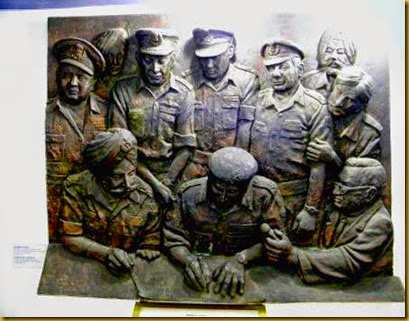The signing of the surrender document
When the children expressed their desire for an outing just before the holidays came to an end, the first choice of that came to mind was the the Shankar’s Dolls’ Museum at ITO, the National Museum at Janpath, the Natural Museum close by and the India Gate to top it. We reached the Shankar’s Doll Museum which is housed in in the National Boot Trust Building at about one 0’ clock in the afternoon and were treated to a display of dolls from all over the world. The greatest take away for all of us was to see dolls from all over the world under one roof. It was like visiting a microcosm of human civilization in different countries. Unfortunately though rightly so, we were not allowed to photograph the dolls as according to the guards, the light might damage the colours of the fabrics of the dolls.
After visiting the Shankar’s Doll Museum, we decided to proceed towards the National Museum at Janpath. We decided to park our vehicles at the India Gate Parking Lot, and then took Autos to the National Museum. The rational was that the parking lot at India Gate closes up by five o’ clock in the evening and they don’t allow visitors to park their vehicles after five, something we had learned to our consternation, a week before when we visited Delhi from Gurgaon.
The Kids at The National Museum
At the National Museum, the first gallery you should visit is the Indus Valley Civilization Gallery which exhibits important artifacts, human remains, implements, jewelry items and of course the famous Bronze dancing girl figurine of the age. The figurine measuring about two inches must be more than three thousand years old!
The Dancing Girl of the Indus Valley Civilization
Next two the Indus Valley Civilization Gallery, one can find galleries that present artifacts and stuff belonging to various Dynasties as old as 200 B.C. A large number of exhibits belong to the Shunga Dynasty, including, I guess the Frieze shown below is so evocative, sensual and realistic – it is amazing how skilled those artisans were more than two thousand years ago!
Imagine, this Fresco is more than two thousand years old!
What struck me most was to see different renditions of Gautam Buddha, one of which appeared to be rather Romanesque in style while the most striking statue was the golden stature of Buddha. I have pasted snaps of all three forms and I am sure that you will notice the subtle variations:
Bodhisattva Head,3rd Century A.D. Kushana Dynasty, Gandharva Art
This is the more traditional rendition of the bust of Buddha
The artefacts of the Mughal period are symbolic of a more sensuous period of art. One example is that of the Peacock Throne made according to the Rajasthani and Pahari tradition. It was taken away by Nadir Shah and placed in the Agra Fort in 1739.
The famous Peacock Throne was studded with semi-precious stones
Another great attraction was the display of weapons and protective armor displayed in the section dedicated to the Moghul period. The sword of Tipu Sultan is one of the exhibits and also the full body armour of Akbar the Great. The weapons used by Aurangzeb feature feature as one of the exhibits.
Swords and daggers used by Aurangzeb
Firearms used by the Moghuls
It was clear that the two hours that we had fixed for out visit to the museum would simply not be enough, as the whole complex is a sprawling one and it would require a good part of the day to even go through half of the exhibits displayed. I would however say that a visit to the National Museums is a must for all children, parents, scholars, artists, and people like me! For students studying fine arts in school, especially at the grade twelve level, a visit to the Museum is a must because these students can study different art forms in India.
The Intricate detail of this statue of Vishnu with his consorts, dated the 13th. Century A.D. from Konark, Orissa is simply amazing!
Sure it was a most enlightening visit and we were all lost in our thoughts looking at those amazing exhibits, proof of the amazing country that is India, and its amazing culture, arts, craftsmanship, aesthetics and advancement throughout the ages!














Awesome post you have here! I will definitely check this out. I'm sure me and my friends are going to like it. You should also check out Ayala Museun, I'm sure you'll like it! Anyway, thanks for sharing.
ReplyDeleteThis all information about national museum helps me a lot for finding best place to visit. Thanks for sharing this one.
ReplyDeleteDelhi museums You should visit
Thanks for sharing this amazing blog about museum in delhi.
ReplyDeleteart museum in delhi
art gallaries in delhi
indian art museum